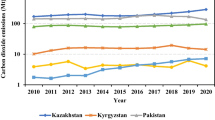Abstract
Promoting environmentally conscious energy policies to reduce carbon emissions is a mutual duty of the international community. Several cities or government regions have implemented strategies and means to reduce carbon dioxide emissions. New efforts focus on introducing green policies, which reduce the largest contributors of the carbon footprint in given regions or islands. This research develops a new approach combining the economic input–output life cycle assessment (EIO-LCA) and location quotient (LQ) approach to measure regional carbon footprint with unique industrial settings. The results enable government policy makers to accurately and effectively formulate policies that target critical contributors while matching expected economic development goals. The case study of Penghu Island in Taiwan shows that the transportation sector has the most significant impact on island-wide carbon emissions. The LQ-based EIO-LCA model is used to analyze the carbon emissions across nine industrial categories and target specific industries that will dramatically lower emissions through incentives and industrial restructuring.
Access this chapter
Tax calculation will be finalised at checkout
Purchases are for personal use only
Preview
Unable to display preview. Download preview PDF.
Similar content being viewed by others
References
Acquaye A A, Duffy A P (2010) Input–output analysis of Irish construction sector greenhouse gas emissions. Building and Environment, Vol. 45, No. 3, pp. 784-791.
Alcántara V, Padilla E (2009) Input–output subsystems and pollution: An application to the service sector and CO2 emissions in Spain. Ecological Economics, Vol. 68, No. 3, pp. 905-914.
Bureau of Energy (2010) Penghu low carbon island development project, Bureau of Energy. Retrieved on 29 November 2010 fromhttp://www.moeaboe.gov.tw/Policy/PoMain.aspx?PageId=polist.
Carnegie Mellon University (2010) Economic input-output life cycle assessment. Retrieved on 10 November 2010 from http://www.eiolca.net/.
Carbon Trust (2010) Carbon footprinting. Retrieved on 29 November 2010 from http://www.carbontrust.co.uk/cut-carbon-reduce-costs/calculate/carbon-footprinting/pages/carbon-footprinting.aspx.
Chang Y, Ries R J, Wang Y (2010) The embodied energy and environmental emissions of construction projects in China: An economic input-output LCA model. Energy Policy, Vol. 38, No. 11, pp. 6597-6603.
Chen F, Duic N, Alves, L M, Carvalho M G (2007) Renewislands- Renewable energy solutions for islands. Renewable and Sustainable Energy Reviews, Vol. 11, No. 8, pp. 1888-1902.
Demiroren A, Yilmaz U (2010) Analysis of change in electric energy cost with using renewable energy sources in Gökceada, Turkey: An island example. Renewable and Sustainable Energy Reviews, Vol. 14, No. 1, pp. 323-333.
Ferguson T M, MacLean H L (2011) Trade-linked Canada-United States household environmental impact analysis of energy use and greenhouse gas emissions. Energy Policy, Vol. 39, No. 12, pp. 8011-8021.
Hsiao C T, Trappey A J C, Ou J J R, Li S J, Chen, Kevin W P (2012) Benefit evaluation of green transportation policy for Penghu low carbon island development using a system dynamics approach. Proceedings of WDSI 2012, Hawaii, April 3-6.
Huang Y A, Matthews H S (2008) Seeking opportunities to reduce life cycle impacts of consumer goods-An economy-wide assessment. Electronics and the Environment (ISEE), San Francisco, CA, 19-22 May 2008, pp. 1-6.
IPCC (2001) IPCC third assessment report. Retrieved on 22 November 2010 from http://www.ipcc.ch/ipccreports/tar/index.htm.
Ju L, Chen B (2010) An input-output model to analyze sector linkages and CO2 emissions. Procedia Environmental Sciences, Vol. 2, pp. 1841-1845.
Lin S M, Huang T H (2006) Resource Utilization Model Update and Maintenance with the Analysis and Policy Simulation. Authorized Project by Council for Economic Planning and Development, Executive Yuan, Taiwan, ROC.
Miller R E, Blair P D (1985) Input–Output Analysis: Foundations and Extensions. In: New Jersey: Prentice-Hall.
Minx J C, Wiedmann T, Wood R, Peters G P, Lenzen M, Owen A, Scott K, Barrett J, Hubacek K, Baiocchi G, Paul A, Dawkins E, Briggs J, Guan D, Suh S, Ackerman F (2009) Input–output analysis and carbon footprinting: An overview of applications. Economic Systems Research, Vol. 21, No. 3, pp. 187-216.
National Statistics, ROC (2007) Manpower survey results in 2006. http://www.dgbas.gov.tw/ct.asp?xItem=18182&ctNode=3247.
National Statistics, ROC (2008) Industry, commerce and service census of 2006 statistical tables. http://eng.stat.gov.tw/lp.asp?ctNode=1624&CtUnit=774&BaseDSD=7.
National Statistics, ROC (2010a) Input coefficients table at producers’ prices (Table 2). Retrieved 22 November 2010 from http://eng.stat.gov.tw/ct.asp?xItem=25743&ctNode=1650.
National Statistics, ROC (2010b) Agriculture, forestry, fishery and husbandry census of 2005 statistical analysis. Retrieved 10 November 2010 from http://eng.stat.gov.tw/lp.asp?ctNode=1633&CtUnit=783&BaseDSD=7
Penghu Country Government (2011) Geographic location. Retrieved on 5 March 2011 from http://www.penghu.gov.tw/eng/00home/home.asp.
Peters G P (2008) From production-based to consumption-based national emission inventories. Ecological Economics, Vol. 65, No. 1, pp. 13-23.
Samso energy academy: Renewable energy Denmark (2010) Updated 10 year anniversary report. Retrieved on 21 November 2010 from
http://www.onlinepdf.dk/Books/onlinepdf.aspx?onlinepdf=24054.97.
Trappey A J C, Trappey C V, Lin G Y P, Chang Y S (2012) The analysis of renewable energy policies for the Taiwan Penghu island administrative region. Renewable and Sustainable Energy Reviews, Vol. 16, No. 1, pp. 958-965.
Uemura Y, Kai T, Natori R, Takahashi T, Hatate Y, Yoshida M (2003) Potential of renewable energy sources and its applications in Yakushima Island. Renewable Energy, Vol. 29, No. 4, pp. 581-591.
Wang J, Lu H, Peng H (2008) System dynamics model of urban transportation system and its application. Journal of Transportation Systems Engineering and Information Technology, Vol. 8, No. 3, pp. 83-89.
Author information
Authors and Affiliations
Corresponding author
Editor information
Editors and Affiliations
Rights and permissions
Copyright information
© 2013 Springer-Verlag London
About this paper
Cite this paper
Trappey, A.J., Trappey, C.V., Liu, P.H., Hsiao, C.T., Ou, J.J., Chen, K.W. (2013). Location Quotient EIO-LCA Method for Carbon Emission Analysis. In: Stjepandić, J., Rock, G., Bil, C. (eds) Concurrent Engineering Approaches for Sustainable Product Development in a Multi-Disciplinary Environment. Springer, London. https://doi.org/10.1007/978-1-4471-4426-7_32
Download citation
DOI: https://doi.org/10.1007/978-1-4471-4426-7_32
Published:
Publisher Name: Springer, London
Print ISBN: 978-1-4471-4425-0
Online ISBN: 978-1-4471-4426-7
eBook Packages: EngineeringEngineering (R0)




